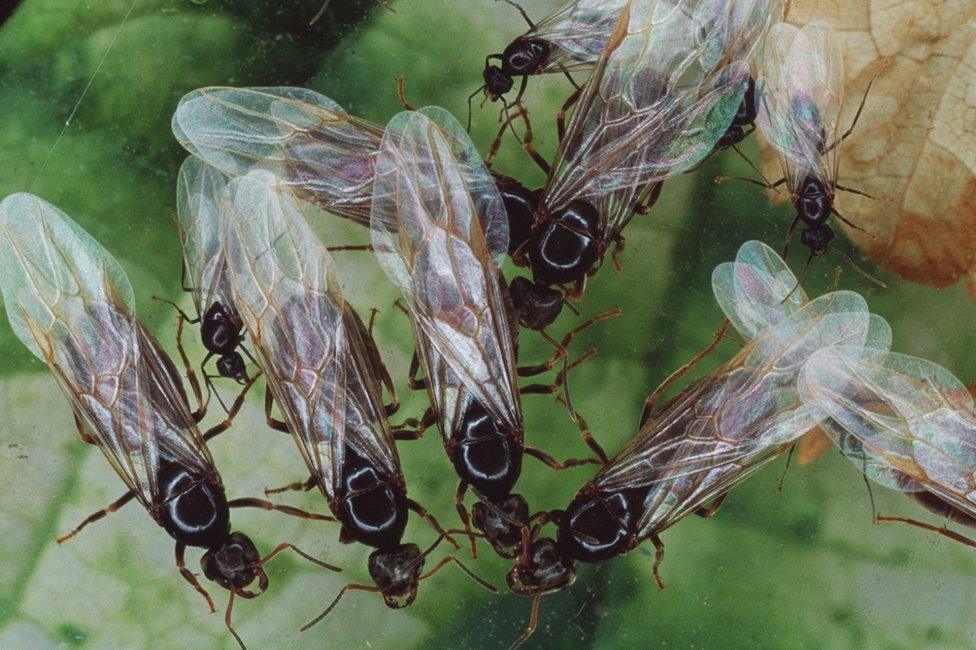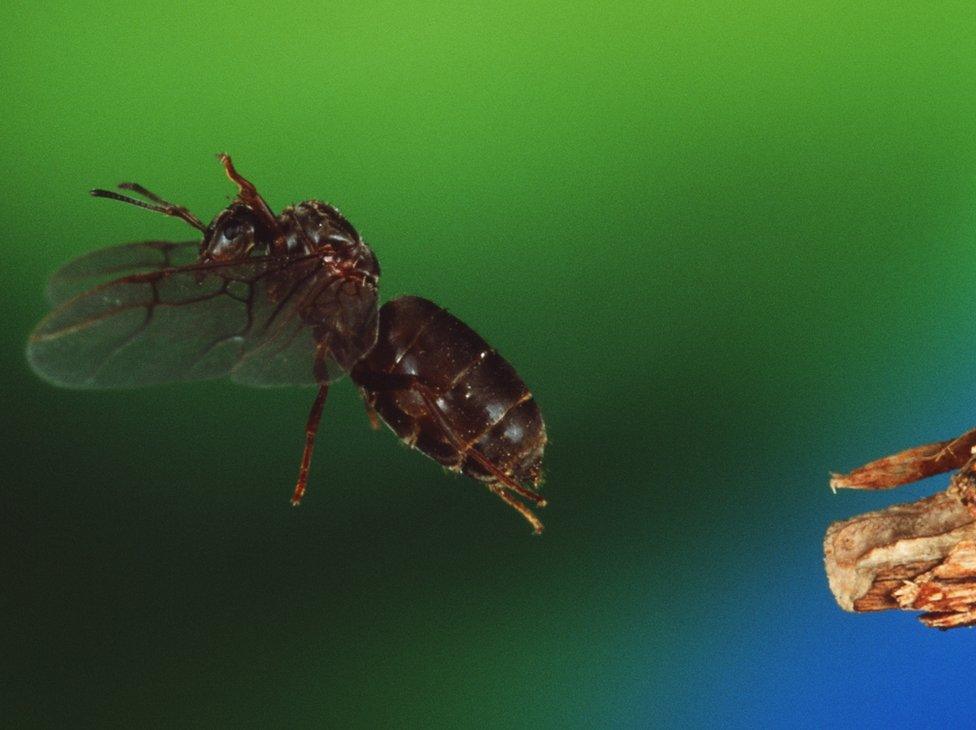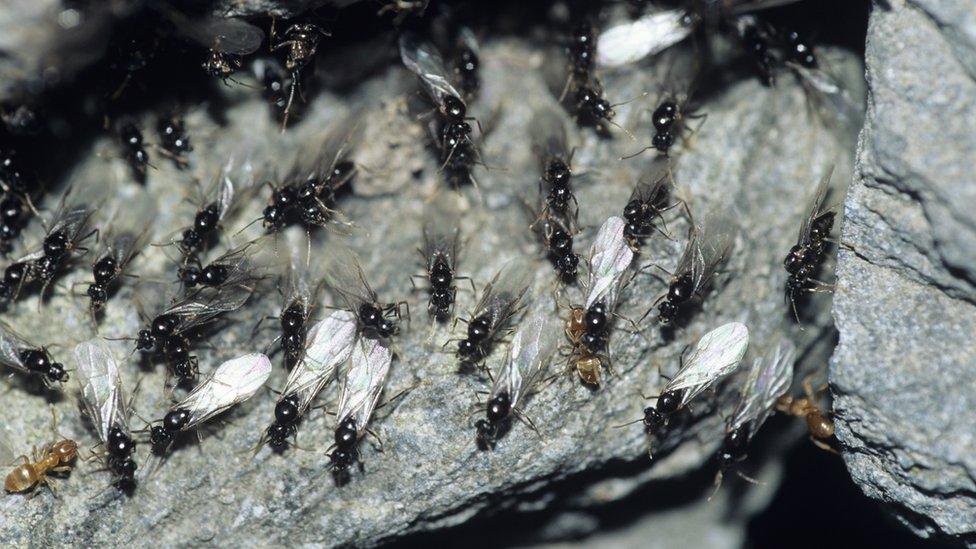Viewpoint: Is there such a thing as 'flying ant day'?
- Published

The emergence of winged ants during summer often provokes a strong public reaction
We're all used to ants sprouting wings and taking to the air during summer, but is there really such a thing as a "flying ant day"? A new study appears to have solved the mystery, using data submitted by the public. Here, Prof Adam Hart, one of the report's authors, explains how they did it.
No one can guarantee a rain-free Bank Holiday weekend or a sun-drenched Wimbledon but, no matter what the summer weather brings, you can guarantee that flying ants will make their annual appearance at some point.
Flying ants are a bit of a surprise for many people. After all, the ants we are used to seeing under stones in our gardens don't have wings and cannot fly. These wingless ants are female workers, toiling to ensure the colony survives and grows.
Once the colony has grown large enough though, it can stop investing in growth and start investing in reproduction. The problem for ants is that workers cannot start a new colony; for that you need a larger, fertile, "queen" ant that has mated with a male from a different colony.
The flying ants we see in the summer are these potential new female queens and male ants embarking on a mating flight.
Once they have mated, on the wing, the females drop to the ground and attempt to start a new colony. Most of them will not make it, becoming bird food or dying before they are able to produce worker ants (their daughters) and develop a new colony.
But some will go on to head up new colonies that will eventually produce their own flying ants

Once ants have mated, females drop to the ground in attempts to start new colonies
The mass emergence of these winged ants across the UK always seems to provoke a strong public and media reaction, but rather than celebrating one of the great spectacles of nature, it seems that most people would much rather it didn't happen at all!
Reading social media feeds during a flying ant event is a lesson in insect-hating, with words like "disgusting", "horrible" and "invasion" being typical. The term "flying ant day", with its implication of a single mass flying event across the country, is virtually ubiquitous.
The emergence of flying ants certainly does give the impression that these mating flights are coordinated across the whole country, and the collective media reporting of them lends weight to the idea that there is a single flying ant day.
But is there really such a day, how coordinated are these flights across the country and what triggers the ants to take to the air on the day or days that they do? These were questions I set out to answer with a team from the University Gloucestershire and the Royal Society of Biology.
It turns out that the widely-held idea of a "flying ant day" is actually a misconception.
Investigating mass events like flying ants presents scientists with a problem; to find out more about what is happening we need to record when and where flying ants are emerging but to do that means being everywhere at once.
With the advent of the internet, and especially the rise of smart phones, scientists have been able to harness the power of the public, who are more-or-less everywhere all the time, to record events for them.
Citizen science, as such scientist-public partnerships have become known, is an increasingly powerful tool being used in all corners of science. We decided to harness the power of the public to find out more about flying ants.

Whether ants flew seemed to be determined both by temperature and wind speed
Starting in 2012 and continuing for three years, the University of Gloucestershire and the Royal Society of Biology, ran an annual online Flying Ant Survey to find out where and when people were seeing flying ants.
After the first year, we also asked some people, "super-engagers" who were keen on doing more, to send us samples of the flying ants from their sightings. Using the thousands of ants returned to us we were able to determine that close to 90% of flying ants were from just one species - the black pavement ant Lasius niger.
We were also able to use the thousands of sightings to say once and for all that the media cliché of Flying Ant Day is a myth.
In fact, what the public-reported data showed us was that flying ants are much less coordinated across space and much less synchronised than we thought.
We found that ants were flying somewhere in the UK on as many as 96% of days between the start of June and the start of September.
The pattern of flying ants differed massively between years. For example, in 2012 there were just a few days in late July and a few more in mid-August where around 80% of the flying activity was focussed.
In 2012, there was a terrible patch of wet and cold weather at the end of July which seems to have concentrated flights in the periods before and after. But in other years we found very different patterns, for example the fine weather in 2013 resulted in "pulses" of ant flights across the country every few weeks throughout the summer.
We had expected to find flights clustered together geographically when we looked at records across the country but we found that flying ants were much less coordinated than we expected, with no clustering at any level at which we looked.
You might have flying ants in your garden one day and your neighbour might have them the week, or even the month, after. Even in your own garden, you might have one colony flying today and another tomorrow.
Waiting game
Although only a small effect, we did find that flying ant emergences move northwards and westwards across the UK over time, so those early flying ants in Wimbledon (the south-east) this year are exactly what we might expect, albeit a couple of weeks earlier than has been reported previously.
Weather turns out to be an absolutely critical factor in triggering ants to fly. By comparing records of flying ants with the nearest weather station data, we were able to untangle some of the factors that trigger ants to take to the sky.
Ants only flew when the temperature was above 13C and when the wind speed was less than 6.3 metres per second but overall ants like it calm and warm. During the course of the study, every day in the UK summer that had a mean temperature above 25C had ants flying somewhere.
The records sent in by the public also showed that ants are excellent at short-term weather forecasting. By examining the changes in weather in the days before and after each flying ant event, we discovered that ants were more likely to fly on days that were warmer and had lower wind speeds than the day before.
It seems that ants are able to judge if the weather is likely to get better or deteriorate. If the weather is going to improve then they will wait, but if it is going to deteriorate then as long as the temperature and wind speed are above their critical thresholds they will fly.
Ants are incredibly important in the ecosystem. As predators they keep on top of other insects and as prey (especially flying ants) they feed many birds and mammals.
Their nest digging helps to aerate and structure soil as well as acting to cycle nutrients. Thousands of people have helped to make sure the emergence of flying ants, forecasting the weather and evading hungry gulls, can be celebrated as a highly visible sign of these vital ecosystem engineers.
This research, by Adam Hart (the author of this article), Anne Goodenough (University of Gloucestershire), Thomas Hesselberg (University of Oxford) and Rebecca Nesbit (Royal Society of Biology) is published in the journal Ecography.